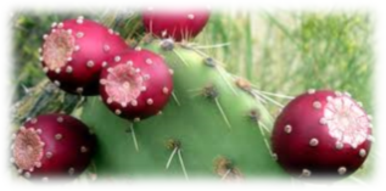|
‘Prickly pear’ is the common name of the fruit that grows at
the tops of the leaves of Nopales cacti. Spread throughout North and South
America, about 200 different species of Nopales (scientific name Opuntia) cacti
are found, all of which have some form of this prickly pear fruit, although not
all varieties are edible. The most commonly used species in terms of eating and
cooking would be the O. ficus-indica, also known as the Indian Fig Opuntia. The
most interesting thing about this fruit is that it grows at the very edge of
the spiny leaves of these imposing cacti, which are some of the hardiest
lowland cacti in the world, a trait also taken on by its fruit. The fruits are
oval in shape, and can range in colour from yellow and light green to orange,
pink, and red, depending on the variety and ripeness.
Before eating a prickly pear, it is very important to remove the skin and peel it off so all of the spines are removed. If they aren’t, the glochids can lodge themselves in your lips, gums, and throat, which can be very painful. After that, however, the fruit can be used for a variety of things, either eaten raw or dry, and made into various jellies and jams, candies, or alcoholic beverages like vodka.
In fact, native Americans often used prickly pears to make colonche, and certain varieties of the cactus possess psychotropic components, including mescaline, making the cactus fruits useful for making Ayahuasca. One of the most popular uses of prickly pear is as a hangover cure, and it has been used to reduce headaches associated with too much alcohol for hundreds (if not thousands) of years.
Although all cacti are technically native to the Americas, prickly pears and its fruit have spread across the world to Egypt, Morocco, various parts of Europe, the Middle East, and Greece. The prickly pears are used for food, as well as alternative medicine treatments, as it has a wealth of nutrients and potential health benefits. Let’s take a closer look at the unique health components found inside prickly pears.
|
|
Some of the health benefits of prickly pear include its ability to lower cholesterol levels, improve the digestive process, decrease the risk of diabetes, boost the immune system, stimulate bone growth, strengthen blood vessels, prevent certain cancers, reduce the risk of Alzheimer’s, aid in weight loss attempts, and eliminate inflammation throughout the body.
Apart from the unusual name, appearance, and origins of this
fruit, it also has a very unique composition of nutrients, including high
levels of vitamin C, B-family vitamins, magnesium, potassium, calcium, copper,
and dietary fibre. In terms of organic compounds, prickly pears have high
levels of flavonoids, polyphenols, and betalains, all of which have a positive
impact on human health.
Immune System Booster: A single serving of prickly pears
contains more than 1/3 of your entire daily requirement of vitamin C. Also
known as ascorbic acid, vitamin C plays a major role in the immune system,
stimulating the production of white blood cells and acting as an antioxidant
throughout the body. Furthermore, vitamin C is an important component of
various enzymatic and metabolic processes, including the creation of bone and
muscle tissue.
Builds Strong Bones and Teeth: Calcium is an integral part
of the human diet, and prickly pears contain a significant level of calcium in
every serving. Calcium is a very important element in the creation of bone
tissue in the body; in fact, 99% of the calcium in your body is found in your
bones and teeth. By ensuring you have enough calcium in your system, you can
prevent various dental issues, as well as age-related bone disorders like
osteoporosis.
Digestive Health: Prickly pears have a significant level of
dietary fibre, like most fruits and vegetables, so these spiny fruits can help
you regulate your digestive process. Fibre bulks up stool to help food pass
through the digestive tract easier, thereby eliminating constipation, bloating,
and more serious gastrointestinal issues, such as colon cancer or gastric
ulcers.
Heart Health: There are a number of components of prickly
pears that make it very good for heart health. First of all, the levels of fibre
in the fruit can help to lower the levels of “bad” cholesterol in the body,
while the significant levels of potassium can help to lower blood pressure, by
relaxing the blood vessels and reducing the stress on the cardiovascular
system. Finally, the betalains found in prickly pear, have been directly
connected to strengthening the endothelial walls of blood vessels, thereby
reducing the chances of weakening or damage to the system. Reducing
cholesterol, lowering blood pressure, and strengthening blood vessels can
prevent atherosclerosis, coronary heart disease, and strokes.
Cancer Prevention: Everyone is looking for the solution or
cure for cancer, but unfortunately, our best bet is still to eat as many antioxidants
as we can to combat the effects of free radicals. Prickly pears have high
levels of flavonoids, polyphenols, and betalains, all of which act as
antioxidant compounds and neutralize free radicals before they can cause
healthy cells to mutate into cancerous cells. Studies have shown lowered
chances of cancer in people who regularly add these types of antioxidants into
their diet.
|

